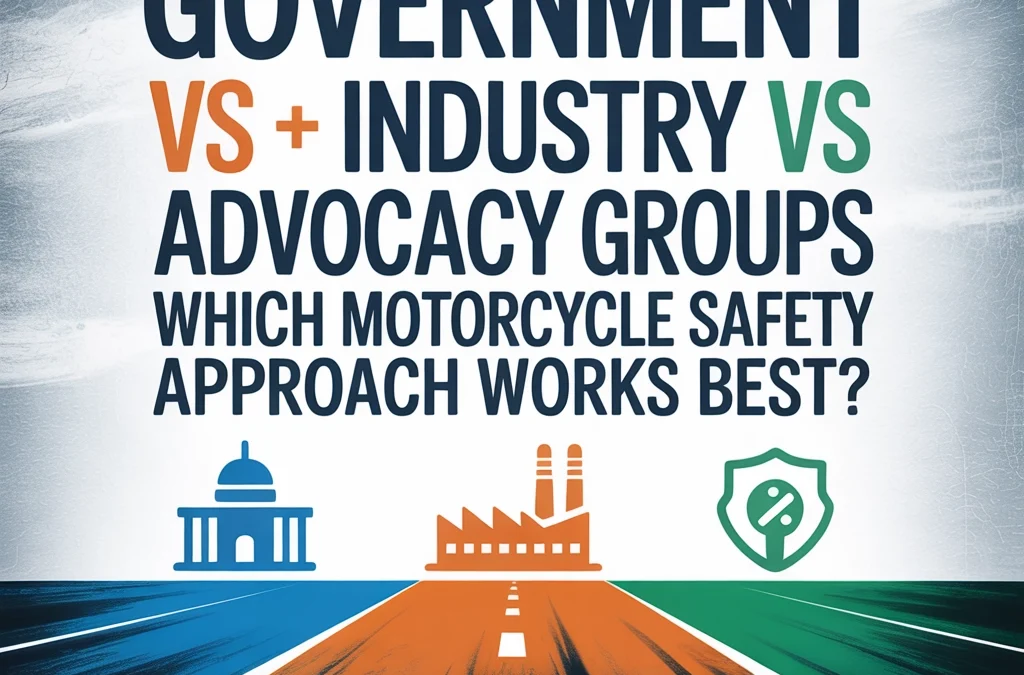Quick Answer: Research shows collaborative approaches combining government authority, industry resources, and advocacy group community engagement achieve the greatest motorcycle safety impact. Malaysia's multi-sector program reduced road crashes by 64% and motorcycle fatalities by 600, while universal helmet laws achieve 94% compliance versus 72% without comprehensive requirements.
When it comes to saving lives on two wheels, who's really making the difference? Is it government agencies wielding regulatory authority and taxpayer dollars? Industry partners bringing innovation and market reach? Or advocacy groups mobilizing communities and maintaining long-term pressure for change?
The answer might surprise you. While each approach has distinct strengths, the most effective motorcycle safety programs don't pick sides – they combine all three for maximum impact.
Government-Led Safety Initiatives: The Power of Policy
Government approaches to motorcycle safety pack a serious punch when properly implemented. Take Malaysia's comprehensive Road Safety Plan as a prime example. This government-led initiative combined community campaigns, infrastructure improvements, and helmet distribution programs to achieve remarkable results.
The numbers tell the story: road traffic crashes decreased by 64%, and motorcycle-specific lanes reduced fatalities by an impressive 600. Over 22,000 motorcyclist deaths were prevented during 1976-2022 through government helmet law enforcement alone.
Universal helmet laws represent government intervention at its most effective. States with comprehensive helmet requirements achieve 94% compliance compared to just 72% in states without such laws. The enforcement authority that only government possesses makes the difference between voluntary adoption and widespread compliance.

Government Advantages:
- Regulatory authority to mandate safety measures
- Access to significant public funding
- Ability to implement large-scale infrastructure changes
- Power to enforce compliance through legal requirements
Government Limitations:
- Bureaucratic delays can slow implementation
- Political resistance may limit program scope
- Limited flexibility in adapting to local conditions
- Age-specific helmet laws prove "virtually impossible to enforce"
Industry-Driven Innovation: Market Solutions for Safety
The motorcycle industry brings a different set of tools to the safety challenge. With existing distribution networks, customer relationships, and profit incentives, industry partners can scale safety solutions rapidly and sustainably.
Industry approaches excel at integrating safety features directly into products, from advanced braking systems to collision avoidance technology. The rise of motorcycle-based delivery and ride-hailing platforms has created new opportunities for industry-led safety initiatives targeting gig economy workers.
The scalability factor cannot be ignored. When manufacturers build safety into their products and dealers promote protective equipment, the reach extends to every customer interaction. This market-driven approach can achieve widespread adoption without relying on regulatory enforcement.
Industry Advantages:
- Private sector efficiency and innovation
- Sustainable funding models through business operations
- Scalability through existing distribution networks
- Direct integration of safety features into products
Industry Limitations:
- Profit considerations may conflict with comprehensive safety goals
- Limited authority to implement systemic changes
- Potential conflicts of interest between business and safety objectives
- Cannot address infrastructure or policy-level issues independently
Advocacy Groups: Community Engagement and Sustained Pressure
State motorcycle safety coalitions demonstrate the unique strengths of advocacy-driven approaches. These organizations unite "government agencies, private organizations and individuals" to achieve common safety goals through sustained community engagement.
Advocacy groups serve as crucial bridges between sectors, maintaining long-term focus on safety issues while mobilizing grassroots support for policy changes. They excel at addressing safety challenges for vulnerable populations, particularly young riders who face disproportionate risks.
The coalition model enables resource sharing while reducing duplicated efforts and increasing access to policymakers and media. This approach proves especially valuable for maintaining momentum on safety initiatives when political priorities shift or industry interests change.

Advocacy Group Advantages:
- Deep community engagement and grassroots mobilization
- Long-term commitment to safety goals
- Ability to bridge gaps between government and industry
- Focus on vulnerable populations often overlooked by other approaches
Advocacy Group Limitations:
- Limited funding compared to government and industry resources
- Lack of regulatory authority to mandate changes
- Struggle to implement large-scale interventions without partner support
- May face challenges in maintaining unified positions across diverse stakeholders
Comparing Effectiveness Across Approaches
Each approach brings distinct strengths to motorcycle safety challenges, but their effectiveness varies significantly across different metrics:
Policy Authority: Government agencies possess the highest level of policy authority, enabling them to mandate safety requirements and enforce compliance. Industry partners have limited authority beyond their own products and services, while advocacy groups must work through influence rather than direct authority.
Resource Access: Both government and industry typically have access to substantial resources, though through different mechanisms. Government funding comes from taxpayers, while industry resources derive from business operations. Advocacy groups generally operate with more limited budgets.
Implementation Speed: Industry approaches often achieve the fastest implementation due to private sector efficiency, while government initiatives face bureaucratic processes that can slow deployment. Advocacy group efforts typically require the longest timeframes due to their focus on building consensus and maintaining engagement.
Community Engagement: Advocacy groups excel at community engagement, maintaining deep connections with riders and safety advocates. Government approaches typically achieve moderate engagement through public campaigns, while industry engagement focuses primarily on customers.
The Winning Formula: Multi-Sectoral Collaboration
Here's where the research gets interesting: collaborative approaches consistently outperform single-sector initiatives. State motorcycle safety coalitions that combine government authority, industry resources, and advocacy group community engagement achieve the most significant safety improvements.
Malaysia's success story exemplifies this collaborative model. The program leveraged government policy authority, industry partnerships for equipment distribution, and community engagement for sustained behavior change. The result? A 64% reduction in road crashes and dramatic decreases in motorcycle fatalities.

The optimal strategy assigns each sector to their strengths:
- Government establishes regulatory frameworks, funds infrastructure improvements, and enforces safety standards
- Industry integrates safety technologies, supports training programs, and scales solutions through market channels
- Advocacy groups maintain community engagement, monitor progress, and pressure for continued improvements
This multi-sectoral approach addresses the complex nature of motorcycle safety through complementary strengths while mitigating individual sector limitations. Government authority provides the framework, industry innovation supplies the tools, and advocacy engagement ensures sustained community support.
Implementing Collaborative Safety Programs
Start with data-driven goals. Successful collaborative programs begin with clear, measurable objectives supported by all participating sectors. Whether targeting helmet compliance, infrastructure improvements, or training participation, specific metrics keep all partners accountable.
Establish clear roles and responsibilities. Each sector should contribute according to their unique strengths rather than duplicating efforts. Government handles policy and enforcement, industry provides products and scalability, advocacy groups manage community engagement and feedback.
Maintain sustained engagement. Unlike single-sector initiatives that may lose momentum with leadership changes or budget constraints, collaborative programs build redundancy across multiple stakeholders. When one sector faces challenges, others can maintain program continuity.
The evidence is clear: while government authority, industry innovation, and advocacy engagement each contribute valuable elements to motorcycle safety, the most effective programs combine all three approaches. Whether you're a safety official, industry professional, or community advocate, the path forward involves building bridges rather than working in isolation.
Ready to enhance motorcycle safety in your community? Visit Ride Fear Free for resources on building collaborative safety initiatives that save lives.
Contact Information:
- Website: www.RideFearFree.net
- AI Receptionist: +1 (970) 693-4854
- CEO: Dan Kost – Connect on LinkedIn
Share this post:
Tags: #Motivation #Branding #Strategy #Marketing #AdvertisingAndMarketing #digitalmarketing #Innovation #Sports #MotorcycleSafety #GovernmentPolicy #IndustryPartnerships #AdvocacyGroups #CollaborativeApproach #SafetyInitiatives #MotorcycleAdvocacy

